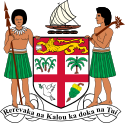
Back Parlamentswahl in Fidschi 2014 German Φιτζιανές γενικές εκλογές 2014 Greek Elecciones generales de Fiyi de 2014 Spanish Élections législatives fidjiennes de 2014 French 2014 ke election (Fiji) HIF Парламентские выборы на Фиджи (2014) Russian 2014 Fijian general election SIMPLE
| |||||||||||||||||||||||||||||||||||||
All 50 seats in the Parliament of Fiji 26 seats needed for a majority | |||||||||||||||||||||||||||||||||||||
|---|---|---|---|---|---|---|---|---|---|---|---|---|---|---|---|---|---|---|---|---|---|---|---|---|---|---|---|---|---|---|---|---|---|---|---|---|---|
| Registered | 591,101 | ||||||||||||||||||||||||||||||||||||
| Turnout | 84.60% ( | ||||||||||||||||||||||||||||||||||||
| |||||||||||||||||||||||||||||||||||||
| |||||||||||||||||||||||||||||||||||||
 |
|---|
| ||
|---|---|---|
|
2006–2022
2022–2023
Timeline
General elections
|
||
General elections were held in Fiji on 17 September 2014 to select the 50 members of Parliament.[1][2][3] The FijiFirst party, led by Prime Minister Frank Bainimarama, won a landslide victory, winning 32 of the 50 seats.[4] The Social Democratic Liberal Party and the National Federation Party were the only other two parties to cross the 5% electoral threshold and win seats.[5]
The elections had originally been scheduled for March 2009, but were delayed because politicians did not agree to the People's Charter for Change, Peace and Progress. Between 2009 and 2014 several public announcements and requests were made for elections, and on 23 March 2014 the interim government announced the elections would be held on 17 September 2014. The elections were to be held under the new constitution which lowered the voting age to 18 and gave the right of multiple citizenship to Fijians for the first time.
Cite error: There are <ref group=lower-alpha> tags or {{efn}} templates on this page, but the references will not show without a {{reflist|group=lower-alpha}} template or {{notelist}} template (see the help page).
- ^ "PM Bainimarama – A Strategic Framework for Change" Archived 21 July 2009 at the Wayback Machine, Fiji government website, 1 July 2009
- ^ "Fiji sets September election date". BBC News. 28 March 2014.
- ^ "Fiji to hold elections next March – People's Daily Online". English.people.com.cn. 9 April 2008. Retrieved 7 April 2011.
- ^ "Fiji coup leader sworn in as PM". Herald Sun. 22 September 2014. Retrieved 8 April 2023.
- ^ "Voter guide" (PDF). Archived from the original (PDF) on 12 September 2014. Retrieved 20 September 2014.





